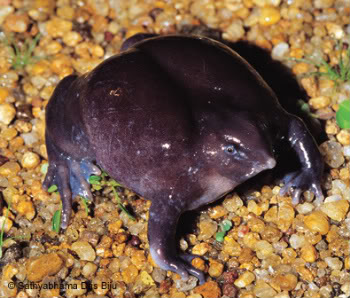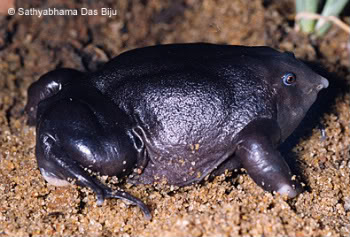Species spends most of its life underground, emerging only during monsoon season
|
|
Discovered only in 2003, the unique purple frog has been captured on film for the first time in India’s Western Ghats. A team of biologists from the University of Delhi, led by Dr. Sathyabhama Das Biju, captured several seconds of film of the frog running swiftly while calling for a mate with a distinct squeak.
The frog evaded discovery for so long, because it spends the majority of its life buried up to four meters underground, only surfacing for a few weeks during India’s monsoon to mate. This is not the only aspect of the species that makes it notable however: the purple frog comprises an entirely new family of amphibian. The family, called Nasikabatrachidae, is the first new amphibian family since 1926. According to the EDGE program, it is believed the frog’s unique family has evolved independently for over 130 million years with the purple frog as its last representative.
 Purple Frog. Photo by Dr. S.D. Biju. Photo courtesy of ZSL.  Purple Frog. Photo by Dr. S.D. Biju. Photo courtesy of ZSL. |
Already classified as endangered in the IUCN red list due to forest loss, conservation plans for this one-of-a-kind species are currently being undertaken by EDGE, a conservation program through the Zoological Society of London devoted to unique and endangered species. Additional funding for the frog’s conservation has been provided by the People’s Trust for Endangered Species.
For footage of the frog please see EDGE’s blog: http://www.edgeofexistence.org/edgeblog
Related articles
Photos of the top 10 most threatened amphibians January 21, 2008
As amphibians decline worldwide, EDGE organization releases list of the 100 most endangered and unique.
Saving forgotten species:
an interview with Carly Waterman, Program Coordinator of EDGE May 27, 2008
In January 2007 a new conservation initiative arrived with an unusual level of media attention. The attention was due to the fact that the organization was doing things differently—very differently. Instead of focusing their efforts on the usual conservation-mascots like the panda or tiger, they introduced the public to long-ignored animals. The new initiative EDGE (Evolutionary Distinct and Globally Endangered), launched by the Zoological Society of London, was not concerned with an animal’s perceived popularity, rather the chose their focal species on a combined measurement of a species’ biological uniqueness and its vulnerability to extinction.